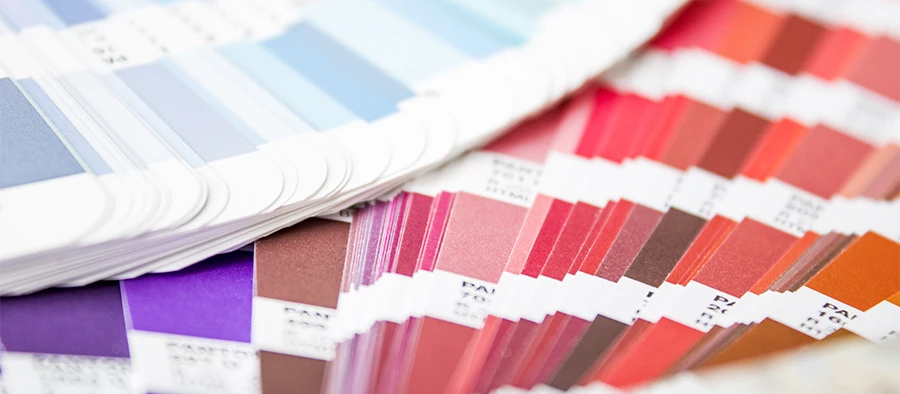
Have a question on printing, products or our services? Find out more below.
If you can’t find the answer you’re looking for, contact one of our friendly team:
E: info@preciouspackaging.co.uk
T: 0845 338 1741
For questions about delivery and returns, click here.
What is CMYK?
CMYK is a colour model that stands for Cyan Magenta Yellow and Key-Black.
These colours are mixed together to create a range of secondary colours.
Values are written in percentages, for example, C:60 M:50 Y:40 K:30 results in a blueish-grey similar to Pantone Cool Grey 10 C.
CMYK printing is cost-effective for designs with five or more colours, as only 4 plates are needed during the printing process.
What is Pantone?
Pantone provides a universal language of colour.
The Pantone Matching System (PMS) is globally available which means our designers can exactly match the colour you need.
Using Pantones which follow a unique coding system, allows for full-colour accuracy.
Can you combine CMYK & Pantone?
Yes.
This is called spot-colour printing or also known as a ‘five-colour printing process.’
Can you mix Pantone colours?
No.
Pantone inks are pre-mixed by printing specialists to ensure global consistency.
What are coated and uncoated Pantone colours?
They are exactly the same ink.
It is the materials that they are printed onto that is different.
Coated paper is smooth and less absorbent.
Uncoated paper is highly absorbent without any extra layers.
This can result in colour variation, such as loss of vibrancy, or slight change in tone.
For full-colour accuracy, we recommend following the universally recognised Pantone book.
What is RGB?
The RGB colour model stands for Red, Green and Blue and are mixed together to make an array of colours. RGB can be represented by decimal numbers from 0 to 255, or alternatively by Hex Code 00 to FF.
Suitable for electronic and screen-based designs RGB is not suitable for printing.
Can you print gradients?
Yes.
A gradient is a fade from one colour to another.
Percentages of inks are printed to create the illusion of a gradient.
Why is CMYK black not 100% black?
In CMYK, K stands for Key-Black.
100% K rarely results in black, rather it comes out in dark grey.
To achieve ‘true black’ in CMYK, we mix the typical solid black ink over one or more of the CMYK colours.
What is 100% ink coverage?
This refers to the amount of print space on your packaging that is printed onto.
For example, if your bag is printed completely blue with an orange logo, this is 100% coverage.
Just to have the orange logo, it would be ~ 30% coverage.
PRODUCTS
What is LDPE and HDPE?
LDPE is ‘Low-Density PolyethylenE’ and is a soft, light and flexible plastic.
Products such as mailbags and clip-handle bags are made from LDPE.
HDPE refers to High-Density PolyethylenE and is much harder and more durable than LDPE.
Products such as T-shirt bags and flexi-loop handles are made from HDPE.
What is the difference between PEVA and non-woven PP?
PEVA stands for PolyethylenE Vinyl Acetate and is plastic that is tough-wearing and weather-proof.
Non-woven PolyPropylene is a softer and breathable plastic and often used for plastic bags.
What is Jute?
Jute is a naturally occurring plant fibre and a very popular environmentally-friendly material.
Its thickness and durability makes it perfect for products such as bags for life.
What’s the difference between woven and non-woven?
Woven materials are made by weaving long fibers of polypropylene together, resulting in a strong material with a criss-cross appearance.
Non-woven polypropylene bags are made by processing fibres of polypropylene simultaneously, giving a cotton-like appearance.
SERVICES
Can you design bags and logos?
Yes.
As standard, we will provide the artwork for your order if you don’t have any.
If you provide us with a vector logo or design, we will send you a design based on your specifications.
Talk to a customer account manager about design options, or take a look at our Design Consultations.
Can you convert a logo into a vector?
Yes.
We charge a conversion fee depending on the complexity of your design.
Get in touch for more details.
What is lead time?
Lead time is the time between the initiation and completion of a production process.
Can I request samples for more than one product?
Yes.
You can send in a sample request via the website.
Speak to one of our friendly team or send us an email for specific requests.
If you can’t find the answer you’re looking for, contact one of our friendly team:
E: info@preciouspackaging.co.uk
T: 0845 338 1741